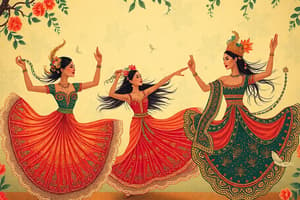Podcast
Questions and Answers
What distinguishes folk dances from other types of dances?
What distinguishes folk dances from other types of dances?
- They have a clear creator with specific choreography.
- They are performed only for entertainment purposes.
- They often involve complex and varied rhythms.
- They reflect the culture and daily life of a community. (correct)
Who is recognized as the Mother of Philippine Folk Dance?
Who is recognized as the Mother of Philippine Folk Dance?
- Lopez
- Pagdiwata
- Francisca Reyes-Aquino (correct)
- Ramon Magsaysay
What is a characteristic feature of ethnic dances?
What is a characteristic feature of ethnic dances?
- They often reflect the historical traditions and social rituals of the community. (correct)
- They typically do not relate to the spiritual or cultural background of a group.
- They are performed only in urban settings.
- They are mostly composed of modern dance movements.
Which of the following examples best represents ritual dances?
Which of the following examples best represents ritual dances?
What type of dance is performed by tribal communities in Northern Luzon?
What type of dance is performed by tribal communities in Northern Luzon?
Which dance is classified as a lowland Christian dance?
Which dance is classified as a lowland Christian dance?
Which classification includes dances influenced by Arabic cultures?
Which classification includes dances influenced by Arabic cultures?
Which of the following is a theme commonly depicted in folk dances?
Which of the following is a theme commonly depicted in folk dances?
What does the Banga dance primarily showcase about Kalingan women?
What does the Banga dance primarily showcase about Kalingan women?
Which of the following dances symbolizes unity and harmony?
Which of the following dances symbolizes unity and harmony?
What is the purpose of Lumagen dance?
What is the purpose of Lumagen dance?
Which dance is characterized by the clashing of bamboo poles?
Which dance is characterized by the clashing of bamboo poles?
What movement does the Itik-itik dance imitate?
What movement does the Itik-itik dance imitate?
What aspect of Filipino culture does Tinikling embody?
What aspect of Filipino culture does Tinikling embody?
Ragrasakan is performed by Kalinga women after which of the following events?
Ragrasakan is performed by Kalinga women after which of the following events?
What is a defining characteristic of the Cariñosa dance?
What is a defining characteristic of the Cariñosa dance?
What does the dance Pantomina primarily celebrate?
What does the dance Pantomina primarily celebrate?
Which dance is a homage to the cross known as Mahal na Poong Alitagtag?
Which dance is a homage to the cross known as Mahal na Poong Alitagtag?
Which dance features Princess Gandingan and incorporates bamboo poles?
Which dance features Princess Gandingan and incorporates bamboo poles?
What type of movements are featured in Kappa Malong-malong?
What type of movements are featured in Kappa Malong-malong?
Pangalay has similarities to which of the following dance forms?
Pangalay has similarities to which of the following dance forms?
In what context is Pantomina typically performed?
In what context is Pantomina typically performed?
The musical accompaniment for Singkil is primarily provided by which ensemble?
The musical accompaniment for Singkil is primarily provided by which ensemble?
Which of the following dances is associated with the Tausug community?
Which of the following dances is associated with the Tausug community?
Flashcards are hidden until you start studying
Study Notes
Philippine Folk Dance Overview
- Folk dances are indigenous expressions of cultural identity, reflecting rituals, beliefs, and everyday life of communities.
- Characteristics include being traditional, expressive, simple rhythmic patterns, and often collaboratively created.
Notable Figure in Folk Dance
- Francisca Reyes-Aquino: First National Artist for Dance and referred to as the Mother of Philippine Folk Dance; recognized in 1926 and awarded the Republic Award of Merit in 1954.
Types of Dance Classifications
- Traditional Dance: Found within specific communities.
- National Dance: Popular across the country; includes examples like Pandango and Cariñosa.
- Ethnic Dance: Originates from specific tribes, showcasing historical and social traditions.
National Dances Examples
- Multiple Pandango variations include Pandango Visayan, Ilocano, Ivatan, Rinconada, and sa Ilaw.
Ethnic Dance Types
- Ritual Dances: depict ceremonies (e.g., Dugso and Pagdiwata).
- Life-Cycle Dances: relate to human events (e.g., Karasaguyon and Daling-daling).
- Occupational Dances: showcase work (e.g., Mag-asik and Binatbatan).
Major Regional Classifications
- Tribal Dances from Cordilleras: Non-Christian dances like Banga, Bendian, Lumagen, Manmanok, and Ragrasakan.
- Lowland Christian Dances: Western-influenced dances, including Cariñosa, Itik-itik, Tinikling, Pantomina, and Subli.
- Muslim Dances: Influenced by Arabic and Indo-Malayan cultures, featuring Singkil, Kappa Malong-malong, and Pangalay.
Tribal Dances from the Cordilleras
- Banga: Women perform balancing acts with jars, showing strength and resilience.
- Bendian: Celebratory circle dance symbolizing unity and harmony after successful headhunting.
- Lumagen: Celebrates harvests and significant life events.
- Manmanok: Mimics chicken movements with cloth, showcasing creativity.
- Ragrasakan: Dance expressing joy after war or hunting success.
Lowland Christian Dances
- Cariñosa: Flirtatious movements, characterized by the use of handkerchiefs, embodying Filipino hospitality.
- Itik-itik: Imitates duck movements, symbolizing grace and connection to nature.
- Tinikling: Energetic dance using bamboo poles, recognized as the national dance for its dynamism and coordination.
- Pantomina: Represents Bicolano culture, performed during important occasions.
- Subli: Honors the Holy Cross, depicting an early tribe's pilgrimage.
Muslim Dances
- Singkil: Portrays Princess Gandingan, emphasizing grace and courage amidst bamboo obstacles.
- Kappa Malong-malong: Dynamic dance with flowing costumes, featuring intricate gestures.
- Pangalay: Celebrated for its similarities to Javanese and Thai dances, often performed at weddings.
Studying That Suits You
Use AI to generate personalized quizzes and flashcards to suit your learning preferences.




